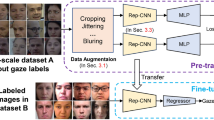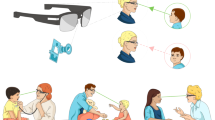Abstract
According to the World Health Organization survey, the global incidence of adolescent mental illness is 28%, while the disease detection rate is only 24.6%. Many existing works use complex eye-tracking devices to study adolescent autism, depression, and other mental illness. In this paper, we propose a gaze estimation method to replace eye-tracking devices. Appearance-based methods with deep learning can predict the point of gaze by using a monocular camera, which requires a large number of samples to learn. However, the samples collected in publicly available gaze estimation datasets are mainly adults and not adolescents. To address the above issue, our work makes two contributions. First, we collected images from 107 adolescents aged 10–14 years by laptops under uncontrolled conditions to create the Young-Gaze dataset. Second, we propose a Multi-scale Feature Fusion-based Calibration Network (MFFC-Net) to deeply fuse the eye-face features for gaze estimation. The proposed MFFC-Net achieves the better performance on Young-Gaze and other public datasets.







Similar content being viewed by others
Data and materials availability
We proposed Young-Gaze dataset in this paper. The dataset is supported by Shanghai Zhangjiang Group Middle School
References
Jacob, R.J.K., Karn, K.S.: Commentary on section 4—Eye tracking in human-computer interaction and usability research: ready to deliver the promises. The Mind’s Eye 2(3), 573–605 (2003)
Majaranta, Bulling.: Eye Tracking and Eye-Based Human-Computer Interaction. In: Proc. Advances in Physiological Computing, 2014, pp. 39–65
Carlos, H.M., Marcio, R.M.M.: Eye gaze tracking techniques for interactive applications. Comput. Vis. Image Underst. 98(1), 4–24 (2005)
Rayner, K.: Eye movements in reading and information processing: 20 years of research. Psychol. Bull. 124(3), 372–422 (1998)
Zhu, Z., Ji, Q.: Novel Eye gaze tracking techniques under natural head movement. IEEE Trans. Biomed. Eng. 54(12), 2246–2260 (2007)
Zhang, W., Zhang, T.N., Chang, S.J.: Eye gaze estimation from the elliptical features of one iris. Opt. Eng. 50(4), 047003 (2011)
Mora, K. A. F., Odobez, J. M.: Geometric Generative Gaze Estimation (G3E) for Remote RGB-D Cameras. In Proc. IEEE CVPR, 2014, pp. 1773–1780
Hansen, D.W., Ji, Q.: In the eye of the beholder: a survey of models for eyes and gaze. IEEE Trans. Pattern Anal. Mach. Intell. 32(3), 478–500 (2010)
Li, J.F., Shan, Y.H., Li, S.G., et al.: Gaze estimation using a head-mounted single full-view camera. J. Electron. Imaging 28(1), 013002 (2019)
Cho, C.W., Lee, H.C., Gwon, S.Y., et al.: Binocular gaze detection method using a fuzzy algorithm based on quality measurements. Opt. Eng. 53(5), 053111 (2014)
Valenti, R., Sebe, N., Gevers, T.: Combining head pose and eye location information for gaze estimation. IEEE Trans. Image Process. 21(2), 802–815 (2012)
Guestrin, E.D., Eizenman, M.: General theory of remote gaze estimation using the pupil center and corneal reflections. IEEE Trans. Biomed. Eng. 53(6), 1124–1133 (2006)
Lee, E.C., Ko, Y.J., Park, K.R.: Gaze tracking based on active appearance model and multiple support vector regression on mobile devices. Opt. Eng. 48(7), 077002 (2009)
Lu, F., Sugano, Y., Okabe, T., et al.: Adaptive linear regression for appearance-based gaze estimation. IEEE Trans. Pattern Anal. Mach. Intell. 36(10), 2033–2046 (2014)
Tan, K. H., Kriegman, D. J., Ahuja, N.: Appearance-based eye gaze estimation. IEEE Workshop on Applications of Computer Vision, pp. 191–195, 2002
Williams, O., Blake, A., Cipolla, R.: Sparse and Semi-supervised Visual Mapping with the S3GP. In: Proc. IEEE CVPR, 2006, pp. 230-237
Zhang, X., Sugano, Y., Fritz, M. et al.: Appearance-based gaze estimation in the wild. In Proc. IEEE CVPR, 2015, pp. 4511–4520
Chen, Z., Shi, B. E.: Appearance-based gaze estimation using dilated-convolutions. In: Proc. ACCV, 2018, pp. 309–324
Fischer, T., Chang, H. J., Demiris, Y.: RT-GENE: real-time eye gaze estimation in natural environments. In: European Conference on Computer Vision, 2018, pp. 339–357
Cheng, Y., Lu, F., Zhang, X.: Appearance-based gaze estimation via evaluation-guided asymmetric regression. In: Proc. ECCV, 2018, pp. 100–115
Krafka, K., Khosla, A., Kellnhofer, P. et al.: Eye tracking for everyone. In: Proc. IEEE CVPR, 2016, pp. 2176–2184.
Cheng, Y., Huang, S., Wang, F. et al.: A coarse-to-fine adaptive network for appearance-based gaze estimation. In: Proc. AAAI, 2020, pp. 10623–10630
Bao, J., Liu, B., Yu, J.: An individual-difference-aware model for cross-person gaze estimation. IEEE Trans. Image Process. 31, 3322–3333 (2022)
Li, J., Chen, Z., Zhong, Y., et al.: Appearance-based gaze estimation for ASD diagnosis. IEEE Trans. Cybern. 52(7), 6504–6517 (2022)
Funes Mora, K. A., Monay, F., Odobez, J. M.: Eyediap: A database for the development and evaluation of gaze estimation algorithms from rgb and rgb-d cameras. In: Proc. Symposium on Eye Tracking Research and Applications, 2014, pp. 255–258.
Zhang, X., Sugano, Y., Fritz, M., et al.: MPIIGaze: real-world dataset and deep appearance-based gaze estimation. IEEE Trans. Pattern Anal. Mach. Intell. 41(1), 162–175 (2019)
Wood, E., Baltruaitis, T., Zhang, X. et al.: Rendering of eyes for eye-shape registration and gaze estimation. In: Proc. IEEE ICCV, 2015, pp. 3756–3764
Wood, E., Baltrušaitis, T., Morency, L. P. et al.: Learning an appearance-based gaze estimator from one million synthesised images. In: Proc. ETRA. ACM, 2016, pp. 131–138
Huang, Q., Veeraraghavan, A., Sabharwal, A.: TabletGaze: a dataset and baseline algorithms for unconstrained appearance-based gaze estimation in mobile tablets. Machine Vision and Applications, 2015
Smith, B. A., Qi, Y., Feiner, S. K.: Gaze locking: passive eye contact detection for human-object interaction. In: Proc. ACM, 2013, pp. 271–280
Fischer, T., Chang, H. J., Demiris, Y.: RT-GENE: real-time eye gaze estimation in natural environments. In: Proc. ECCV, 2018, pp. 339–357
Kellnhofer, P., Recasens, A., Stent, S. et al.: Gaze360: physically unconstrained gaze estimation in the wild. In: Proc. IEEE ICCV, 2019, pp. 6911–6920
Sugano, Y., Matsushita, Y., Sato, Y.: Learning-by-synthesis for appearance-based 3D gaze estimation. In: Proc. IEEE CVPR, 2014, pp. 1821–1828
Zhang, X., Sugano, Y., Fritz, M. et al.: It's written all over your face: full-face appearance-based gaze estimation. In: Proc. IEEE CVPRW, 2017, pp. 2299–2308
Zhang, X., Park, S., Beeler, T. et al.: ETH-XGaze: a large scale dataset for gaze estimation under extreme head pose and gaze variation. In: Proc. ECCV, 2020, pp. 365–381
Park, S., Aksan, E., Zhang, X.: Towards end-to-end video-based eye-tracking. In: Proc. ECCV, 2020, pp. 747–763
Jie, H., Li, S., Gang, S.: Squeeze-and-excitation networks. In: Proc. IEEE CVPR, 2018, pp. 7132–7141
Woo, S., Park, J., Lee, J. Y.: CBAM: convolutional block attention module. In: Proc. ECCV, 2018, pp. 3–19
Fu, J., Liu, J., Tian, H. et al.: Dual attention network for scene segmentation. In: Proc. IEEE CVPR, 2019, pp. 3141–3149
Acknowledgements
This work was supported in part by Wenzhou Major Scientific and Technological Innovation Project under Grant ZY2023003, in part by Medical Health Science and Technology Project of Zhejiang Provincial Health Commission under Grant 2022PY091, and in part by ShangDa Translation Medicine Funding supported by Wenzhou Institute of Shanghai University under Grant SDTMF2022KP06.
Author information
Authors and Affiliations
Contributions
Xiaofeng Lu, Zichen Zhao and Weitao Ke wrote the main manuscript text, and Qingsong Yan prepared all figures and tables. Zhi Liu reviewed and revised the manuscript.
Corresponding author
Ethics declarations
Conflict of interest
We have no known competing financial interests or personal relationships that could have appeared to influence the work reported in this paper.
Additional information
Publisher's Note
Springer Nature remains neutral with regard to jurisdictional claims in published maps and institutional affiliations.
Appendices
Appendix
Network details
See Tables
5,
6,
7,
Rights and permissions
Springer Nature or its licensor (e.g. a society or other partner) holds exclusive rights to this article under a publishing agreement with the author(s) or other rightsholder(s); author self-archiving of the accepted manuscript version of this article is solely governed by the terms of such publishing agreement and applicable law.
About this article
Cite this article
Lu, X., Zhao, Z., Ke, W. et al. Young-gaze: an appearance-based gaze estimation solution for adolescents. SIViP 18, 7145–7155 (2024). https://doi.org/10.1007/s11760-024-03381-0
Received:
Revised:
Accepted:
Published:
Issue Date:
DOI: https://doi.org/10.1007/s11760-024-03381-0




